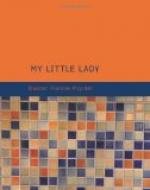“How places and things change!” said Madelon, as they drove along; “we have had two disappointments to-day—shall we have a third, I wonder? Supposing Jeanne-Marie should have gone to live in another house? Ah! how glad I shall be to see her again!—and she will be pleased to see me, I know.”
As she spoke, the scattered houses, the church, the white cottages of Le Trooz came in sight. Madelon checked the driver as they approached the little restaurant, the first house in the village, and she and Graham got out of the carriage. The bench still stood before the door, the pigeons were flying about, and the bee-hives were on their stand, but the blue board was gone from the white wall, and the place had a deserted look.
“It is strange,” said Madelon. She pushed open the door that stood ajar, and went into the little public room; it was empty; the table shoved away into one corner, the chairs placed against the wall—no signs of the old life and occupation.
“Can Jeanne-Marie have gone away, do you think?” said Madelon, almost piteously. “I am sure she cannot be here.”
“I will inquire,” said Graham.
He went out into the road, and stopped a little girl of ten or twelve years, who was walking towards the village with a pitcher of water.
“Do you know whether the woman who lived in this house has left?” he asked. “Jeanne-Marie she was called, I think?”
The child stared up at the strange gentleman with the foreign accent:
“Jeanne-Marie that used to live here?” she said. “She is dead.”
“Dead?” cried Madelon. The tears came rushing into her eyes. “Ah! why did I not know? I would have come if I had known. When did she die?”
“More than a month ago,” the girl answered; “she died here in this house.”
“And who lives here now?” inquired Graham.
“Jacques Monnier—he that works at the factory now. He is out all day; but his wife should be here.”
And in fact, at the sound of the voices, the door leading into the kitchen opened, and a young woman appeared.
“Pardon,” said Madelon, going forward; “we came here to inquire for Jeanne-Marie; but she—she is dead, we hear.”
“Yes, she is dead,” the woman replied; then, in answer to further questions, told how Jeanne-Marie, when she was taken ill, had refused to let any one be written to, or sent for; and had died alone at last with no one near her but a hired nurse. “She left enough money for her burial, and to have a wooden cross put on her grave,” said the woman, “and asked M. le Cure to see that all her things were sold, and the money given to the poor.”
“Is she buried here?” said Madelon. “Horace, I should like to see her grave.”
“Louise, there, can show it to you,” says Madame Monnier, pointing to the child; “run home with your water, ma petite, and then come back and show Monsieur and Madame the road to the churchyard.”




